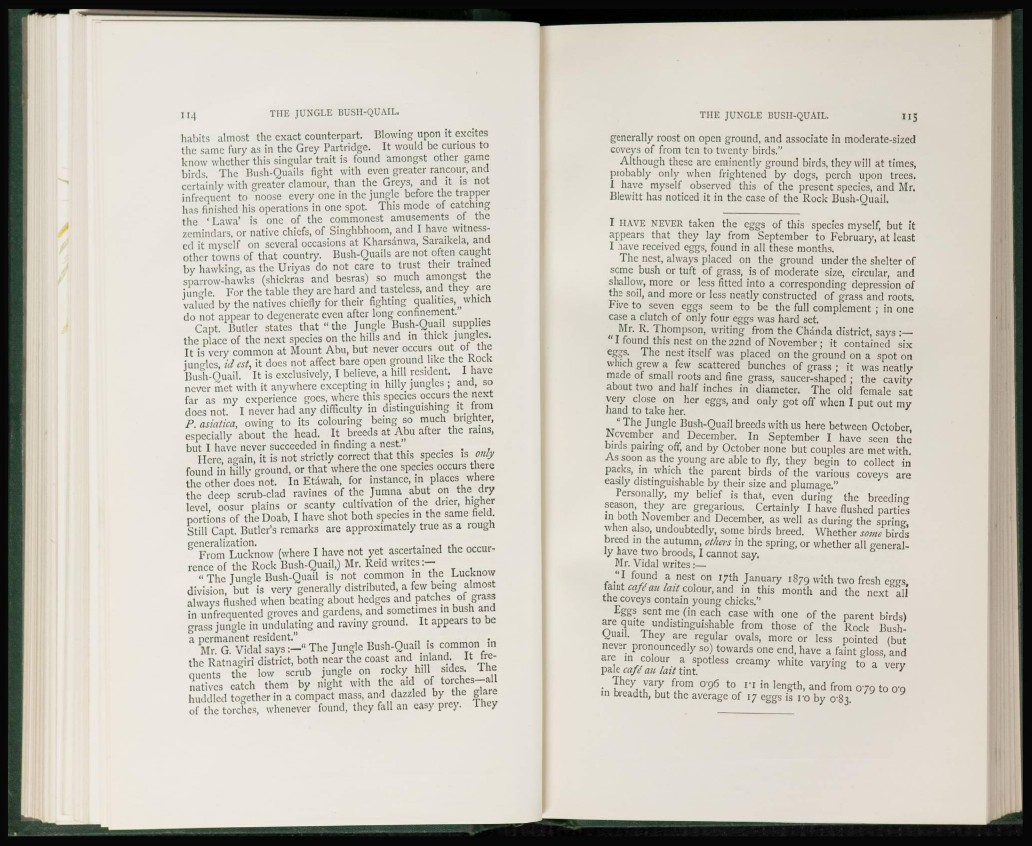
habits almost the exact counterpart. Blowing upon it excites
the same I'ury as in the Grey Partridge. It would be curious to
know whether this singular trait is found amongst other game
birds. The Bush-Quails fight with even greater rancour, and
certainly with greater clamour, than the Greys, and it is not
infrequent to noose every one in the jungle before the trapper
has finished his operations in one spot. This mode of catching
the ' Lawa' is one of the commonest amusements of the
zemindars, or native chiefs, of Singhbhoom, and I have witnessed
it myself on several occasions at Kharsanwa, Saraikela, and
other towns of that country. Bush-Quails are not often caught
by hawking, as the Uriyas do not care to trust their trained
sparrow-hawks (shickras and besras) so much amongst the
jungle. For the table they are hard and tasteless, and they are
valued by the natives chiefly for their fighting qualities, which
do not appear to degenerate even after long confinement."
Capt. Butler states that " the Jungle Bush-Quail supplies
the place of the next species on the hills and in thick jungles.
It is very common at Mount Abu, but never occurs out of the
jungles, id est, it docs not affect bare open ground like the Rock
Bush-Quail. It is exclusively, I believe, a hill resident. I have
never met with it anywhere excepting in hilly jungles ; and, so
far as my experience goes, where this species occurs the next
docs not. I never had any difficulty in distinguishing it from
P. asiaticci, owing to its colouring being so much brighter,
especially about the head. It breeds at Abu after the rains,
but I have never succeeded in finding a nest."
Here, again, it is not strictly correct that this species is only
found in hilly ground, or that where the one species occurs there
the other does not. In Etawah, for instance, in places where
the deep scrub-clad ravines of the Jumna abut on the dry
level, oosur plains or scanty cultivation of the drier, higher
portions of the Doab, I have shot both species in the same field.
Still Capt. Butler's remarks are approximately true as a rough
generalization.
Prom Lucknow (where I have not yet ascertained the occurrence
of the Rock Bush-Quail,) Mr. Reid writes:—
" The Jungle Bush-Quail is not common in the Lucknow
division, but is very generally distributed, a few being almost
always flushed when beating about hedges and patches of grass
in unfrequented groves and gardens, and sometimes in bush and
grass jungle in undulating and raviny ground. It appears to be
a permanent resident."
Mr. G. Vidal says:—" The Jungle Bush-Quail is common in
the Ratnagiri district, both near the coast and inland. It frequents
the low scrub jungle on rocky hill sides. The
natives catch them by night with the aid of torches—all
huddled together in a compact mass, and dazzled by the glare
of the torches, whenever found, they fall an easy prey. They
generally roost on open ground, and associate in moderate-sized
coveys of from ten to twenty birds."
Although these are eminently ground birds, they will at times,
probably only when frightened by dogs, perch upon trees.
I have myself observed this of the present species, and Mr.
Blewitt has noticed it in the case of the Rock Bush-Ouail.
I HAVE NEVER taken the eggs of this species myself, but it
appears that they lay from September to February, at least
I have received eggs, found in all these months.
The nest, always placed on the ground under the shelter of
some bush or tuft of grass, is of moderate size, circular, and
shallow, more or less fitted into a corresponding depression of
the soil, and more or less neatly constructed of grass and roots.
Five to seven eggs seem to be the full complement ; in one
case a clutch of only four eggs was hard set.
Mr. R. Thompson, writing from the Chanda district, says :—
" I found this nest on the 22nd of November ; it contained six
eggs. The nest itself was placed on the ground on a spot on
which grew a few scattered bunches of grass ; it was neatly
made of small roots and fine grass, saucer-shaped ; the cavity
about two and half inches in diameter. The old female sat
very close on her eggs, and only got off when I put out my
hand to take her.
"The Jungle Bush-Quail breeds with us here between October,
November and December. In September I have seen the
birds pairing off, and by October none but couples are met with.
As soon as the young are able to fly, they begin to collect in
packs, in which the parent birds of the various coveys are
easily distinguishable by their size and plumage."
Personally, my belief is that, even during the breeding
season, they are gregarious. Certainly I have flushed parties
in both November and December, as well as during the spring,
when also, undoubtedly, some birds breed. Whether some birds
breed in the autumn, others in the spring, or whether all generally
have two broods, I cannot say.
Mr. Vidal writes:—
" I found a nest on 17th January 1879 with two fresh eggs,
faint cafe au lait colour, and in this month and the next all
the coveys contain young chicks."
Eggs sent me (in each case with one of the parent birds)
are quite undistinguishable from those of the Rock Bush-
Quail. They are regular ovals, more or less pointed (but
never pronouncedly so) towards one end, have a faint gloss, and
are in colour a spotless creamy white varying to a very
pale cafe au lait tint.
They vary from 0-96 to r i in length, and from 079 to 0'9
in breadth, but the average of 17 eggs is r o by o'83.